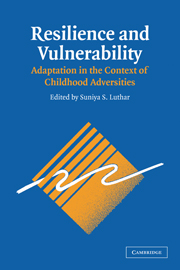Book contents
1 - A Resilience Framework for Research, Policy, and Practice
Published online by Cambridge University Press: 05 June 2012
Summary
It was a search for understanding the nature and origins of schizophrenia that brought Norman Garmezy to the study of children at risk for psychopathology, a pursuit that eventually led to the Project Competence studies of competence, adversity, and resilience (Garmezy, 1973). During the 1940s and 1950s, Garmezy developed an interest in the significance of competence in the history and prognosis of patients with serious mental disorders, with a particular focus on premorbid functioning in patients with schizophrenia (Garmezy & Rodnick, 1959). Eventually, the search for antecedents of psychopathology led Garmezy and others to study children of mentally ill parents because of their elevated risk of developing disorders. After his move to the University of Minnesota in 1961, Garmezy began to focus his work on children, and subsequently played a leading role in an international consortium of investigators who adopted the risk strategy for uncovering clues to the etiology and possible prevention or treatment of serious mental disorders (Watt, Anthony, Wynne, & Rolf, 1984).
It was not long before Garmezy's interest in competence resurfaced. He became intrigued with observations that many children at risk for psychopathology were developing surprisingly well. By the early 1970s, he and his students turned their attention to the study of competence in children at risk due to parental mental illness and other risk factors, including poverty and stressful life experiences. At this time, Garmezy named his research program Project Competence.
- Type
- Chapter
- Information
- Resilience and VulnerabilityAdaptation in the Context of Childhood Adversities, pp. 1 - 26Publisher: Cambridge University PressPrint publication year: 2003
References
- 310
- Cited by



